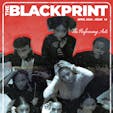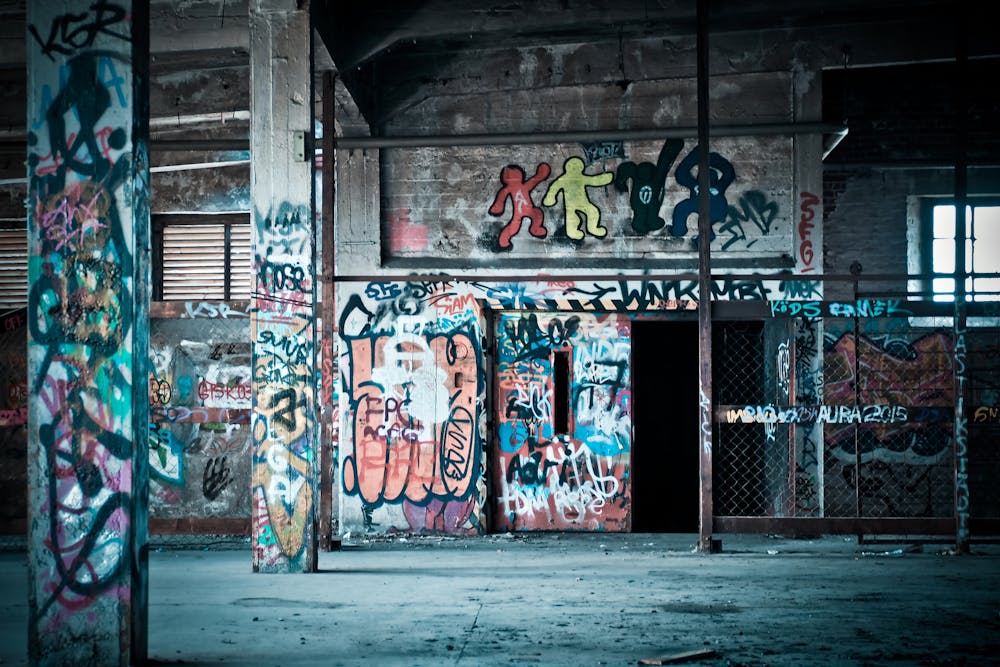Graffiti is ubiquitous. Driving by abandoned homes, underneath bridges, or even through busy streets, I had passed by graffiti without giving it the time of day. I may have spared a few a glance, and been able to identify a few familiar ones on my everyday drive to and from school, but it wasn’t until I moved to D.C. that I truly started thinking about the graffiti I saw on the streets. I was on the metro subway with a friend looking at the passing scenery when we rode past an intricately done tag, a street artist’s signature, layered with greens, blues, and white. Something about it struck a thought within me; I thought about much time and effort must be put into this kind of expression, and how although it is considered an art form by some, it is considered a crime by all. The seemingly simplistic words spray-painted on buildings and landmarks have such a rich history with complex racial politics surrounding it and provide accessibility to create art for artists of all backgrounds. These factors combined are why instead of brushing graffiti off as vandalism and a crime, it should be recognized as a valid art form.
The art of graffiti existed long before the very buildings used as canvases today were built. Written graffiti was created alongside the invention of a writing system in the West, originating with the Ancient Greeks, who were the first group of people to learn to write and therefore the first to express themselves scripturally. This kind of graffiti has been seen in a variety of other cultures as well, such as Mayan, Viking, and Renaissance cultures.
As for non-written graffiti, believers of Christianity in Egypt would etch religious imagery into buildings, ranging from images of fish (which were a symbol of Christ) to the Virgin Mary with Jesus. Both drawn and written American graffiti began in the early colonial era. Popular subjects of said graffiti for two centuries were drinking, defecating, and politics. A well-known symbol from this era was the image of a man peering over a wall with the words “Kilroy was here” positioned underneath. Kilroy is an example of the evolution of graffiti, how two separate styles (written and illustrative) were combined into one.
Like Kilroy, graffiti has changed and evolved, with different looks and styles. It wasn’t until the late 1960’s that the modern style of graffiti emerged. Today’s style of graffiti is rooted in the hip-hop movement; a popular trend was that artists would stand with graffiti-covered backdrops for music videos. When hip-hop transitioned to being mainstream in the 1990s, graffiti art moved with it, popularizing the backdrops that featured graffiti. While it’s easy to pinpoint the general origin of where mainstream graffiti started, who popularized the style.
The first modern-day graffiti artist goes by the name of Cornbread. According to director Sean McKnight, Cornbread was the “Father of modern graffiti.” Cornbread, or Darryl McKay, was a Black man based in Philadelphia, who spraypainted the tag (signature) Cornbread on public property. Cornbread’s “illegal” art not only was artistic in the physical sense but was a form of performance art. By hiding and running to find canvases, Cornbread was risking a certain freedom, but the artist still pursued the art form, no matter how troublesome it could be. Graffiti artists after Cornbread were inspired and followed suit, breaking laws and spray-painting simplistic words in bright lively colors, customizing the size, lettering, and placements. Public property remained stagnant as the chosen canvas.
While some credit Cornbread for popularizing graffiti, another artist by the name of Taki 183 is also credited for spreading the movement. According to Marisa Gómez, author of “The Writing On Our Walls: Finding Solutions Through Distinguishing Graffiti Art form Graffiti Art Vandalism”, “It is believed that graffiti first appeared on New York ghetto and barrio walls as scrawlings of "Taki 183.” Taki was Demetrius, a Greek teenage boy living in a blue-collar Manhattan neighborhood. Taki was featured in a New York Timesarticle in 1971 titled, “'Taki 183' Spawns Pen Pals”, which credits him for being the first graffiti artist to inspire the movement.
It’s important to note that the graffiti community was, and still is, predominantly associated with people of color. In cities such as Los Angeles and New York, most artists were from inner-city Latinx and Black communities. As the movement grew, so did the graffiti artist community, with an increase in the amount of white and Asian artists becoming involved. However, the movement still consists mostly of the Black and Latinx communities.
While Taki, a white boy, was given publicity, Cornbread, a Black man, was not. For a movement so associated with people of color, the figureheads of the movement are very white. Things are still the same today. One of the biggest graffiti artists is known as Banksy, who is allegedly Robin Gunningham, a white man. Banksy’s art has been placed in museums and sold by popular brands, making him one of the most well-known names of the graffiti movement. But popular artists such as Roger Gastman, Banksy, and Caleb Neelon (all of whom are white) moved from the street to the walls of galleries and private collectors in the USA. While these artists may have gained fame and recognition, they strayed away from graffiti’s origins, taking away the rebelliousness and original purpose of the art form. White artists predominantly represent the graffiti movement, but oftentimes they stray away from the performance aspect of graffiti, begging the question of whether they still deserve to be (or ever deserved to be) main representatives of a movement they no longer accurately partake in.
While a select amount of artists have been praised for their graffiti, the movement is still heavily stigmatized. This is mainly due to the use of graffiti amongst gangs, otherwise known as gang graffiti. Gangs have utilized graffiti for very specific purposes: to mark territories, to send messages and insults to other gangs, and to warn away intruders. In areas with gang graffiti, there may be increased criminal activity and violence over the defacement of said graffiti by other gangs. This strong association of graffiti with gang violence, according to Gómez, “incites fear because its opponents mistakenly believe that because gangs use graffiti, any graffiti necessarily brings about increases in gang activity, violence, and crime.” Despite most graffiti not being gang associated and non-violent, the fear perpetuates the stigma surrounding graffiti, encouraging it to be covered up and criminalized.
A rhetoric commonly used to exploit the fear of gang violence and encourage the criminalization of graffiti is stating that graffiti symbolizes a “lack of control” in the regulation of a community. In 2017, the Ottawa Police Services released this statement using the same rhetoric, “When graffiti is left to spread in the community it can leave the impression that nobody cares or that nobody is in control. This is called the ‘Broken Window’ syndrome. When graffiti is allowed to spread it can harm economic development and can lead to further disorder and more significant crime to property.” Here, the Ottawa police are seen blaming graffiti for harming the economy and increasing crime. and New York used similar strategies to blame graffiti for the decline in quality of life and that it represented an “uncontrolled and uncontrollable” environment. However, by placing the blame of civic disorder on graffiti, the blame is also placed on graffiti artists, who are majority Black and Latinx. Not only does this harm the reputation of graffiti artists and take away from the validity of graffiti as an art form, but it perpetuates institutional racism and racist stereotypes that Black and Latinx people are criminals.
While graffiti is stigmatized and criminalized, murals are held high with praise. Murals serve a multitude of purposes, such as celebrating heritage, giving jobs to youth, creating a sense of community, and providing a chance for self-expression. However, graffiti does the exact same things. Additionally, much of mural art, especially in Los Angeles, has evolved from gang graffiti. Graffiti and murals are the same art form, simply shown in a different limelight.
Some could even argue that graffiti serves the same purposes as murals. Graffiti has been used as a means of expression for those in marginalized groups. Their message will be seen by all who walk past and grab the attention of many. Graffiti also acts as a bridge between communities that may be physically separated by space, allowing messages to be passed through that may not have been seen or heard otherwise. Additionally, graffiti is an accessible means for artists to develop their skills. All one needs is a can (or cans) or spray paint, rather than other art supplies that are more expensive. Some artists use graffiti to support themselves by building their artistic portfolios and improving their art so that they may gain employment or receive scholarships. Just as murals provide self-expression opportunities, community, and even jobs, so can graffiti.
The world behind a single word spray-painted in public is deceivingly complicated. Like
all art forms, the history of graffiti traces back to ancient civilizations and has been maintained
throughout time, changing and evolving. As graffiti has had time to evolve, it has been clouded
with racial politics and issues; what was once fun and harmless has been stigmatized and
criminalized. At its core, graffiti is still art, providing the same benefits and enrichment that
murals and other forms of respected art do today. So, the next time you pass by a work of graffiti,
whether it be walking through the city or driving under a bridge, appreciate it for what it is, not
some random piece of vandalism left by a criminal, but a thought-out piece of art made by a
visionary.



